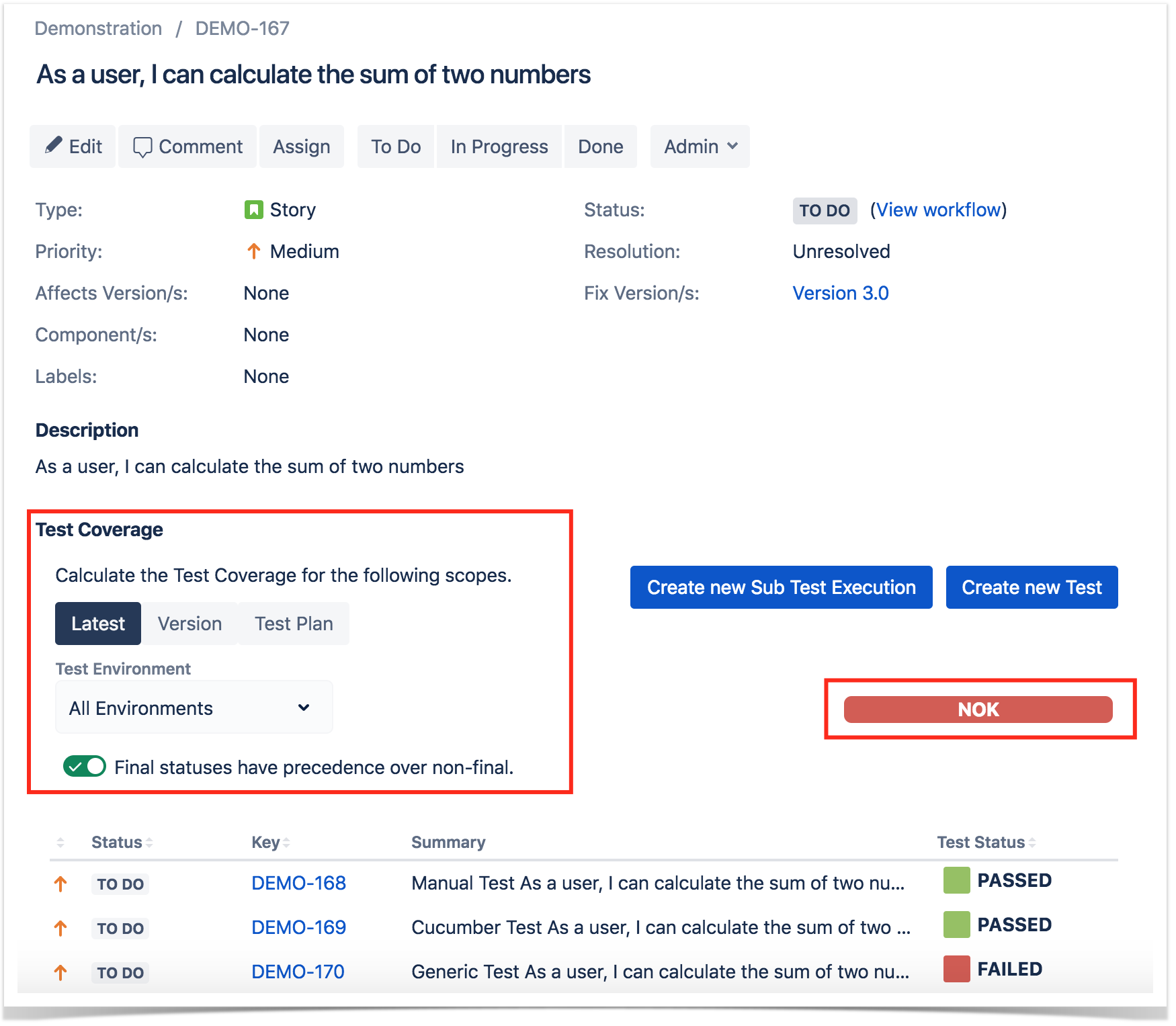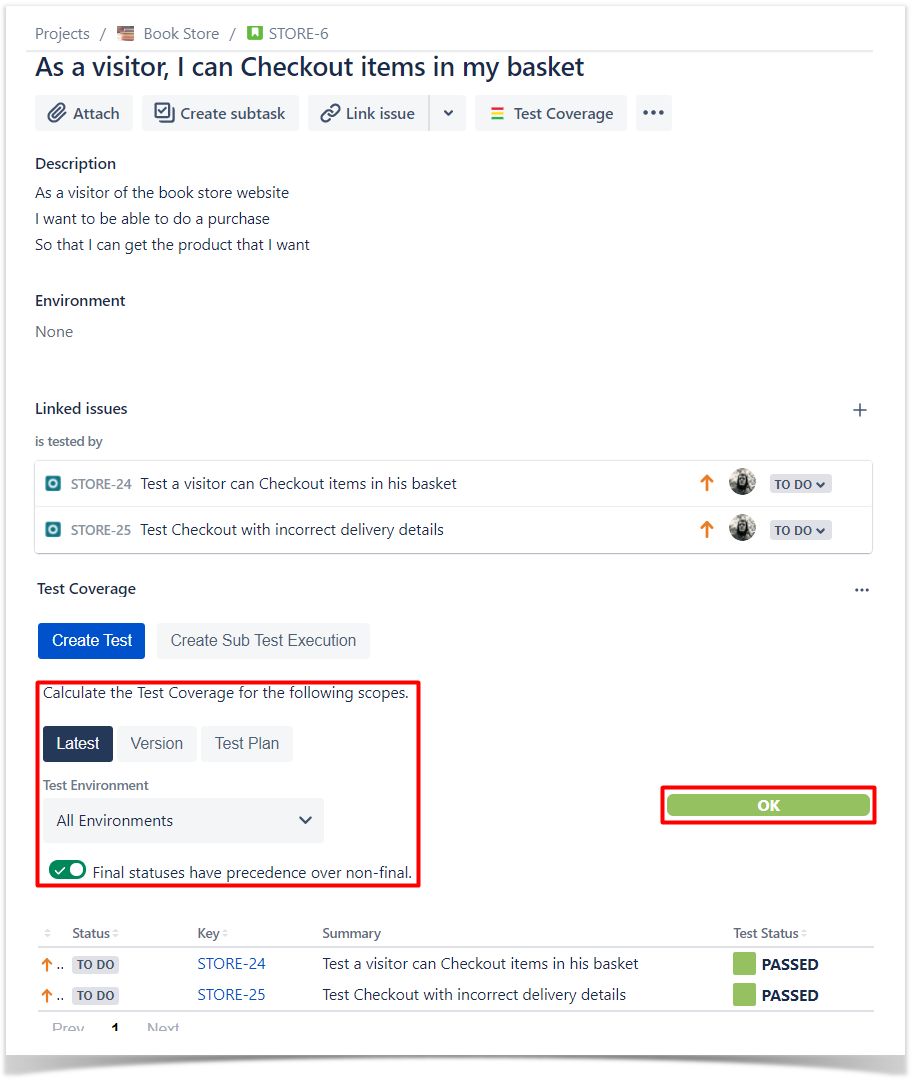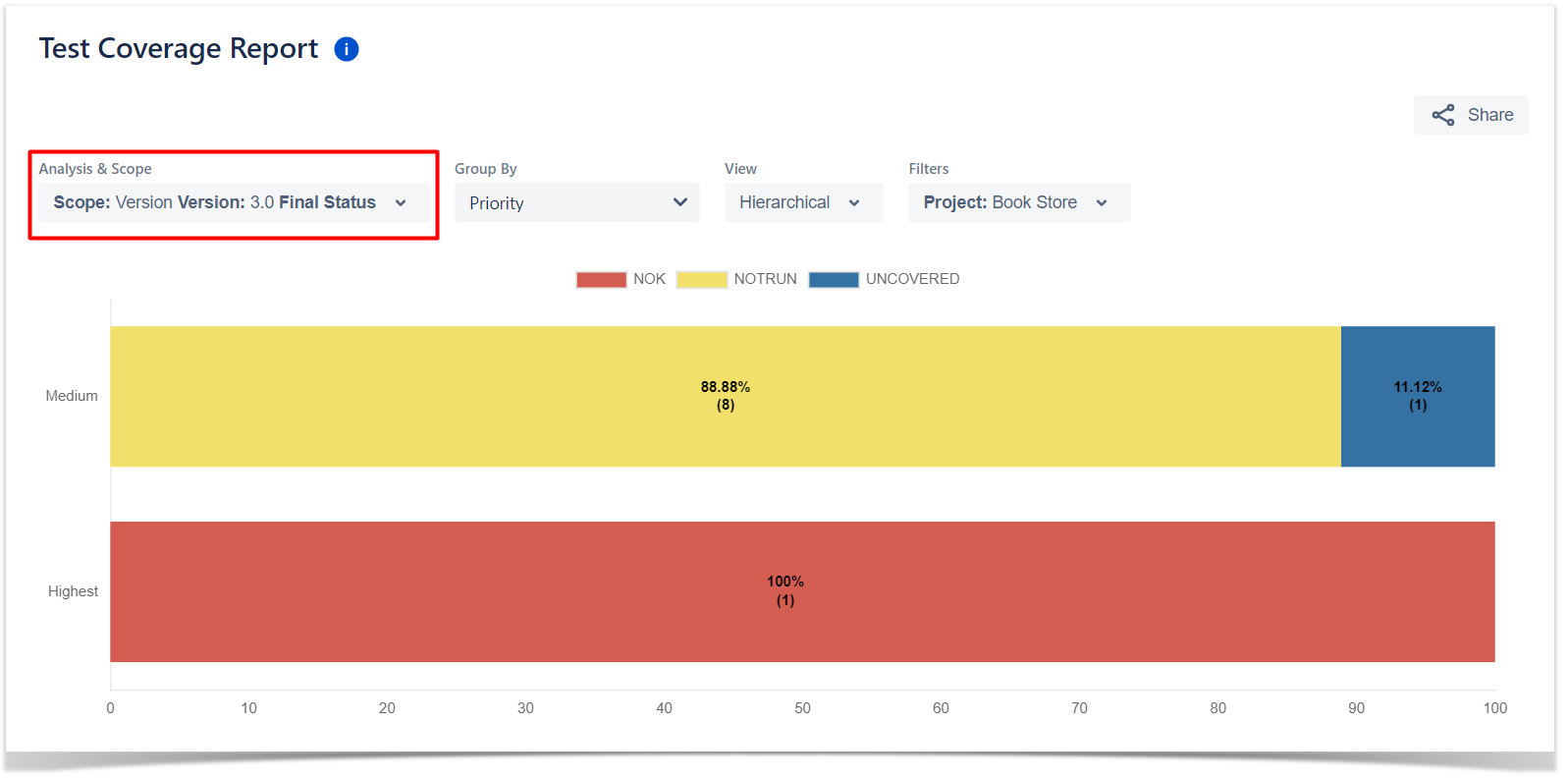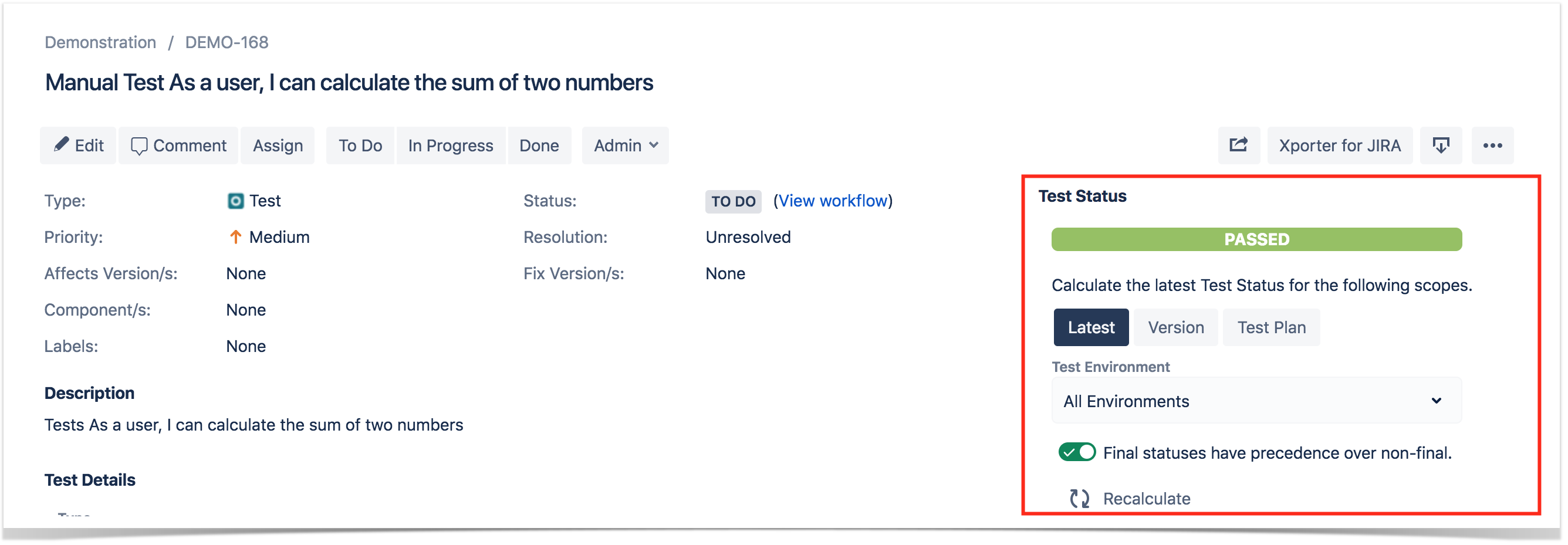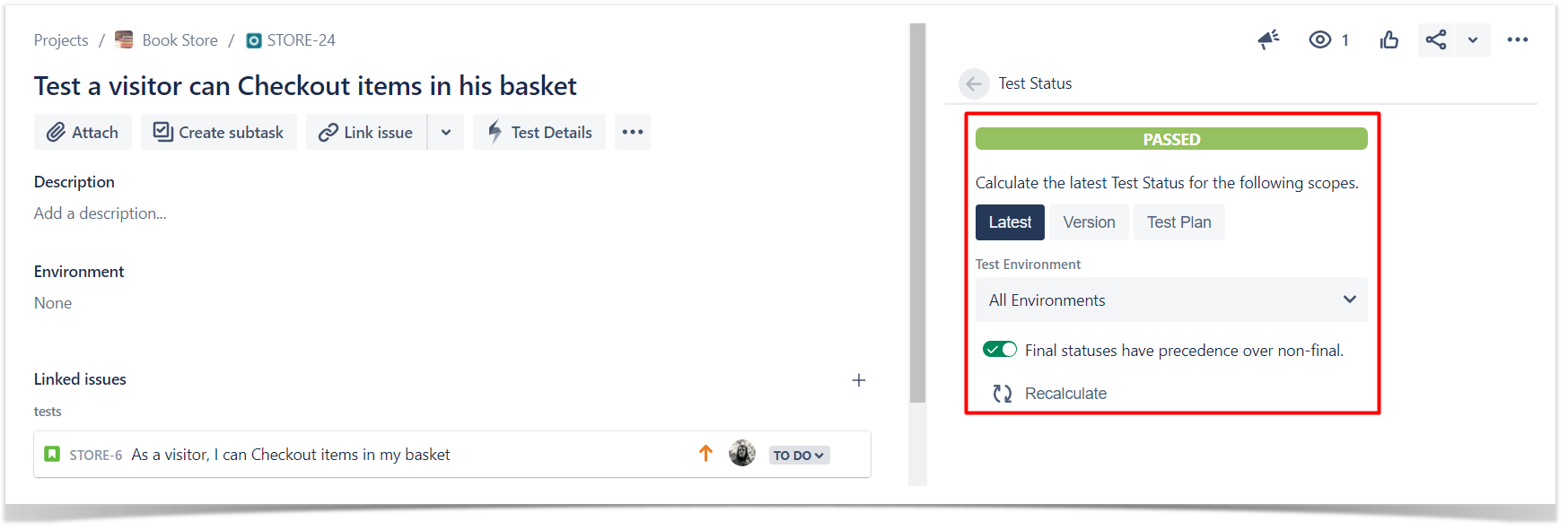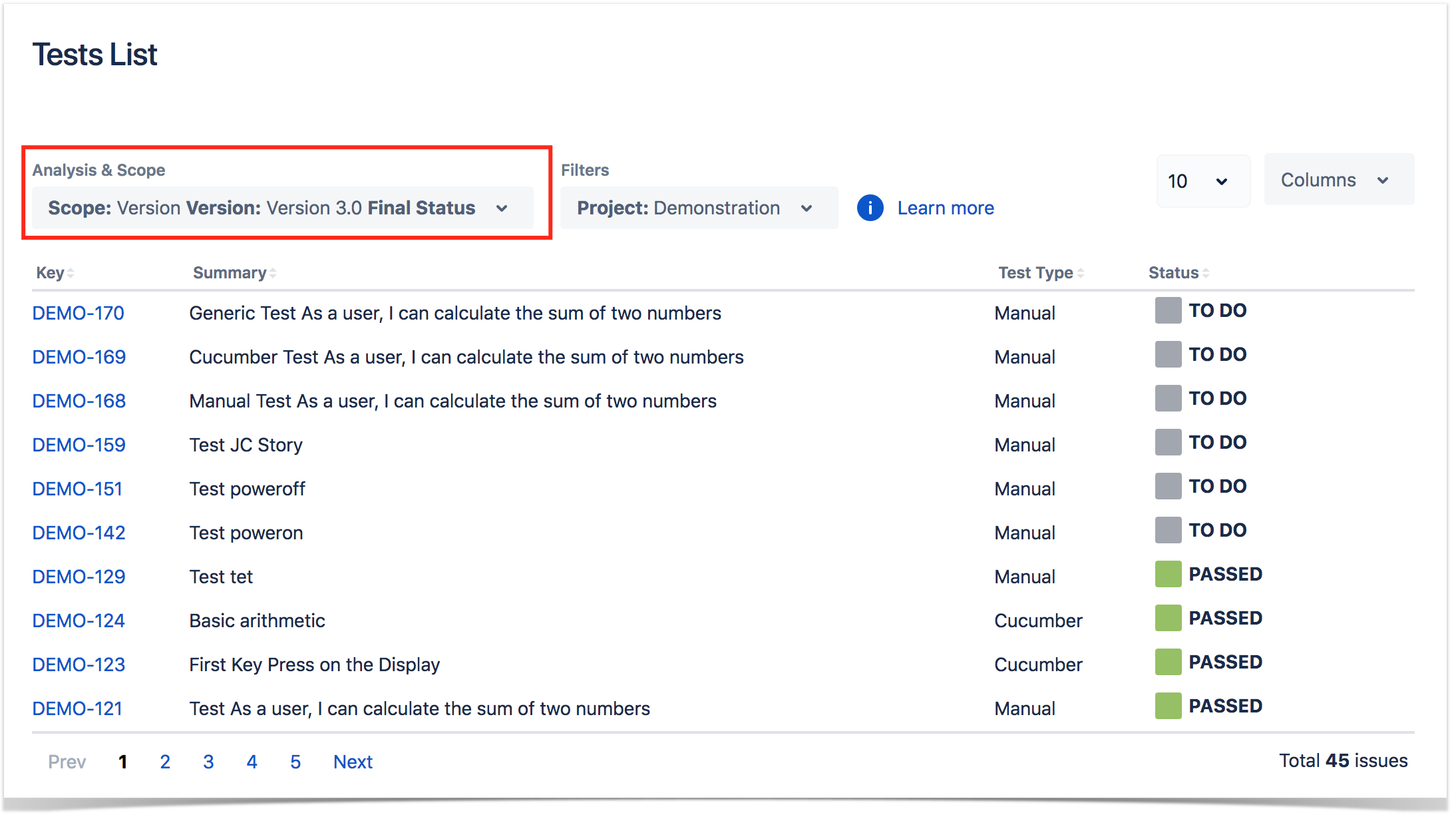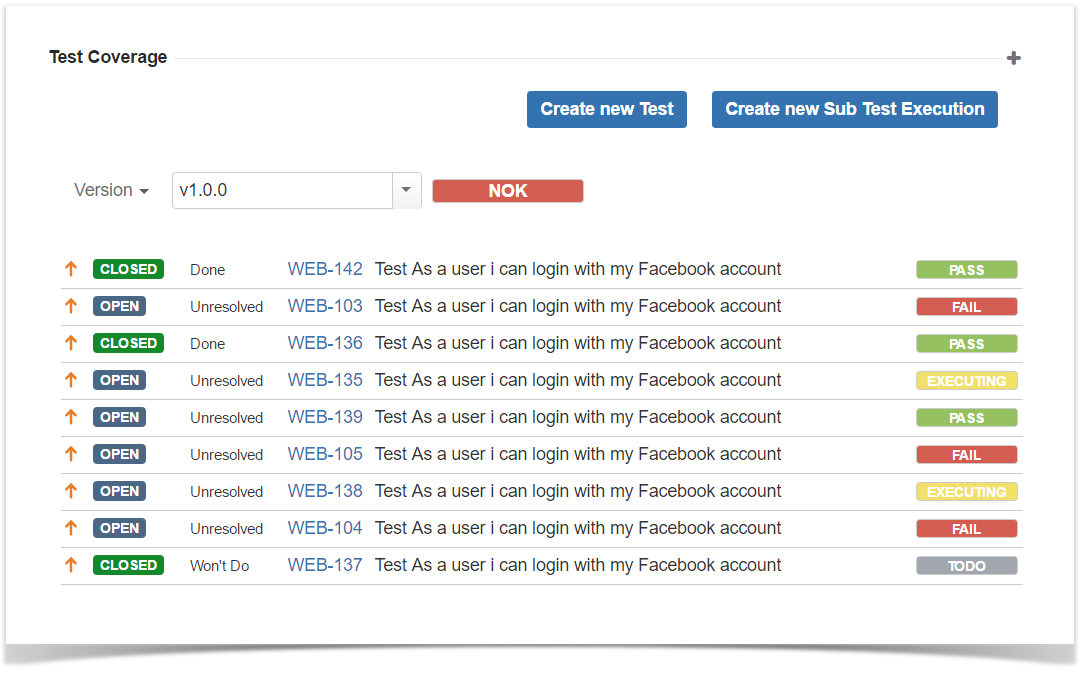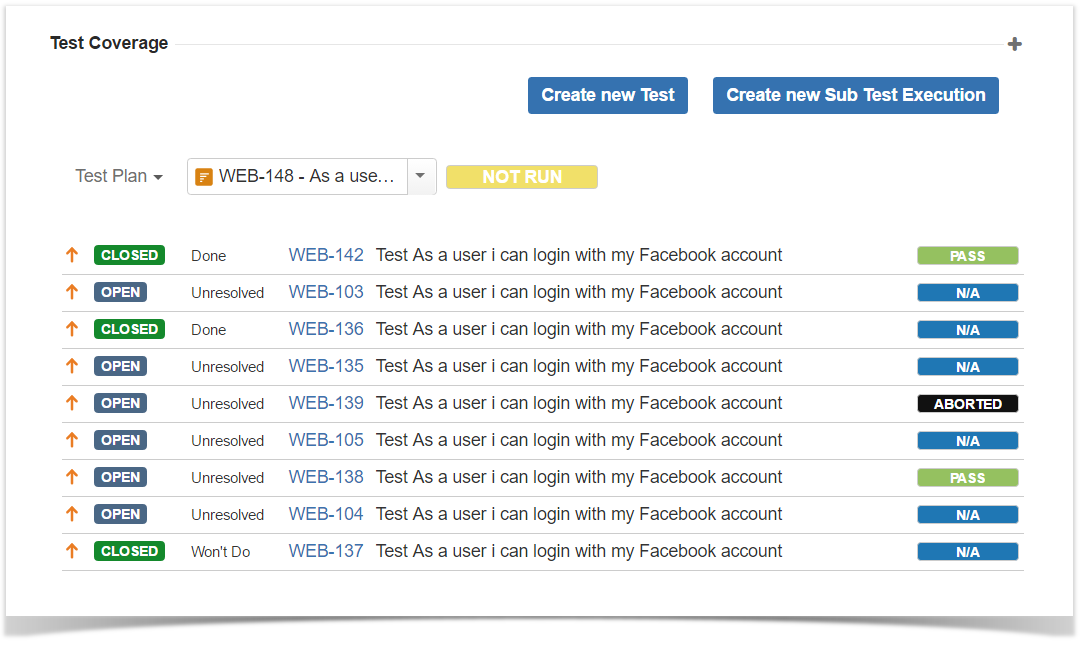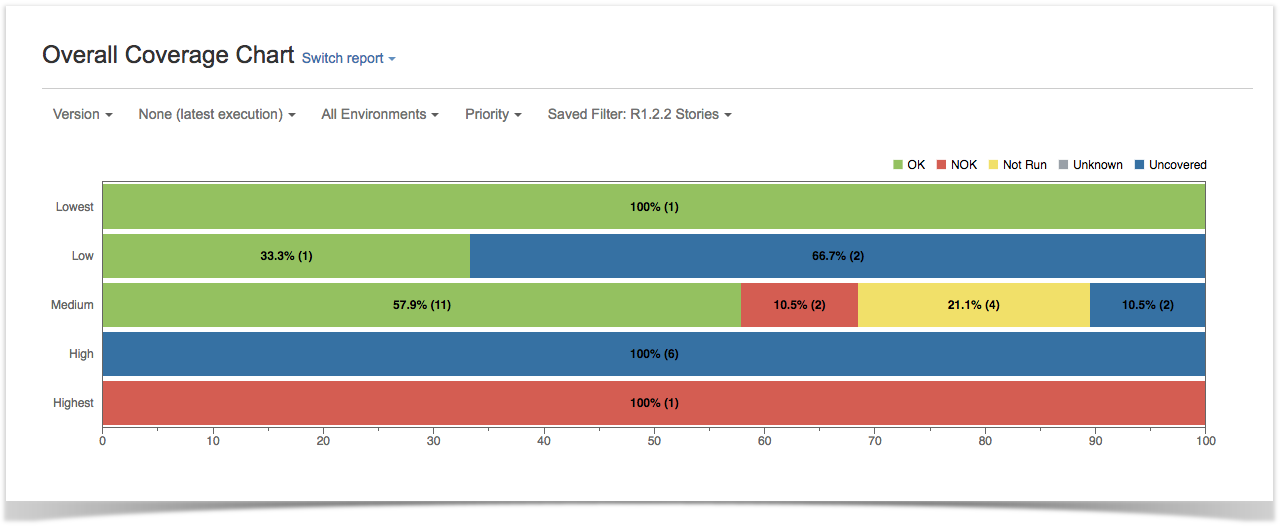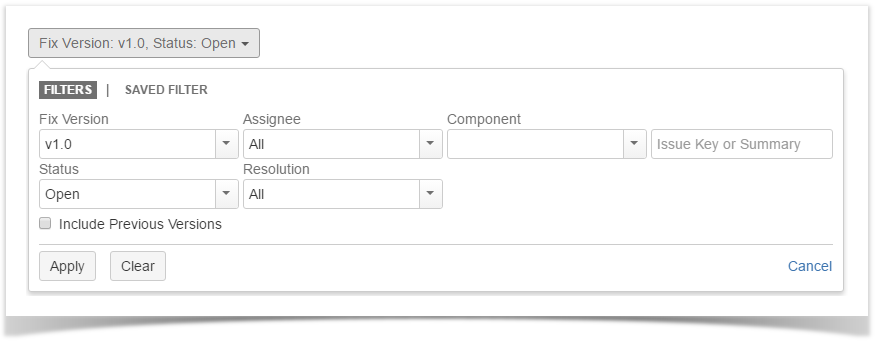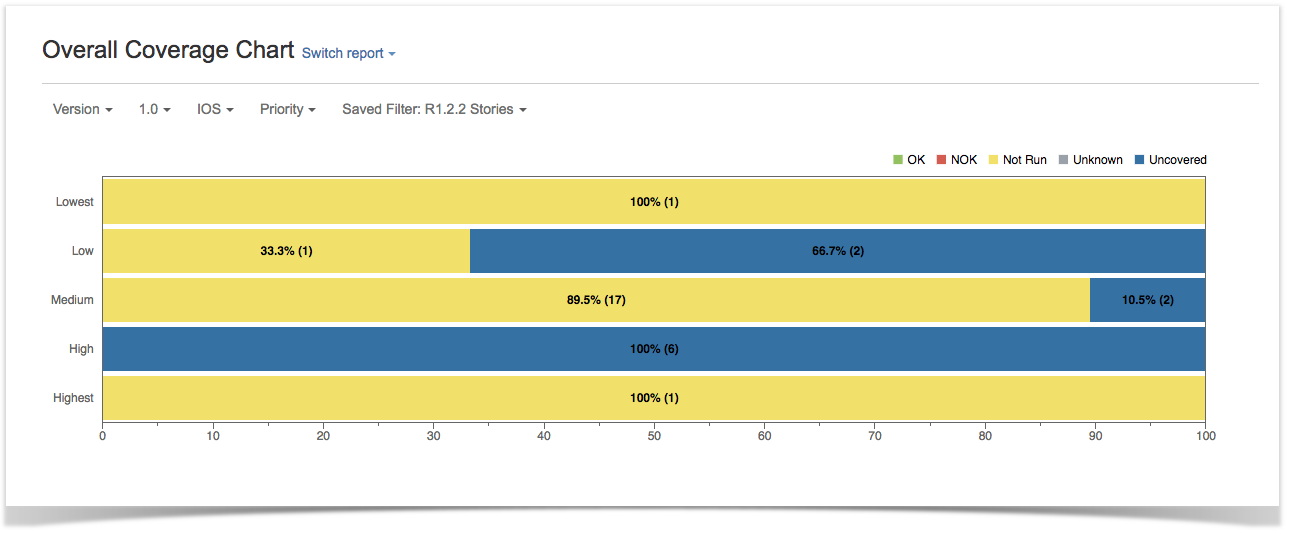Page History
| Anchor | ||||
|---|---|---|---|---|
|
| Table of Contents |
|---|
| Info | ||
|---|---|---|
| ||
Please read Understanding the calculation of coverage status and the status of Tests for a more an in-depth explanation of the calculation of these statuses. |
...
Tests and coverable issues can be analyzed from different perspectives/scopes.
As an example, the The same Test or Story can be analyzed, for example, on version 1.0 and also on version 2.0. This will take into account the respective executions made for those versions, respectively.
Therefore, a story Story may be OK on version 1.0, but may be NOK on version 2.0 , due to regressionsregression.
In fact, Tests and coverable issues can be analyzed from these scopes (or dimensions):
- Latest
- Version
- Test Plan
Besides these scopes, they They can also be analyzed based with some additional criteria that will affect the calculated values, such as:
- Test Environment
- Final statuses precedence over non-final ones
...
If you don't care about versions, or are you're not using versions at all , and just want to see the calculated statuses based on the latest runs, analysis by "Latest" can be used for that purpose.
This may be is useful to have a quick idea about view of the latest results or calculated status for the Test or coverable issue.
Please note Note that whenever when analyzing by latest results, it also considers the latest results made for in the different environments (i.e., when "All Environments" is selected as Test Environment).
...
The "Version" scope allows users to analyze Tests and coverable issues from a version perspective and answer questions such as . It helps address such questions as
- "How is the requirement on version X?"
...
- "How are these Tests performing on version Y?"
...
Whenever When analyzing by version, only the Test Executions made for the given version are considered (i.e., through the Test Execution's Fix Version field).
As an example, a user story aimed for version 3.0 may be analyzed from the point of view of the executions made for version 3.0 or for the ones made afterwards on version 4.0.
Test Plan
Analysis by Test Plan This gives you the ability to evaluate the Test status or coverage status based on some planned testing (i.e., on the Tests and related executions made in the scope of the selected Test Plan).
Whenever When analyzing by Test Plan, only the Test Executions linked to that Test Plan are considered.
This kind of analysis provides to means allows you to evaluate if a given coverable issue is covered or not by the Tests of some Test Plan and, if or not. If so, then you can see how is it is going based on the executions performed from the related planned Test Executions.
...
Analysis by Test Environment gives the ability to analyze the Test status or the coverage status of an issue for some Test Environment.
This kind of analysis gives the abilitty to answer questions such as: It addresses such questions as "How is this requirement doing on the environment X?", "How is the Test
When Whenever analyzing by Test Environment, only Test Executions made for the given Test Environment are considered.
...
Final statuses precedence is used to perform the analysis based on "finished work" (non-intermediate Test Runs).
The flag "Final statuses have precedence over non-final statuses" gives the additional ability to consider just those Test Runs whose status is one configured as being a final status.
This helps answer address questions such as:
- "What is the current status of this requirement (or test)?" (if final statuses precedence is unchecked)
- "What is the status of this requirement (or test), considering just the finished work?" (if final statuses precedence is checked)
...
Xray entities can be analyzed in different places, starting with the issue view screen and also as well as in some specific reports containing those entities.
...
The status of coverable issues can be evaluated directly in the issue view screen and also as well as on some reports, including the Tests Coverage report.
...
Within the issue screen, the coverage status can be evaluated for the specified scope within the Test Coverage section. The calculated coverage status is shown on the right side.
Reports
Test Coverage
Coverable issues can be analyzed for some a given scope using the Test Coverage report. More info about this report in Test Coverage Report. The chosen scope will be store in the user preferences, and will affect all issues in the same project.
Tests
The status of Tests can be evaluated directly in the Test issue view screen and also as well as on some reports, including the Tests List report and, indirectly, the Test Sets List report.
...
Within the Test issue screen, the Test status can be evaluated for the specified scope. The calculated status is cached for performance reasons; since . Since data can be unsynced between Jira and Xray may not be in sync, it's possible to enforce a recalculation and show to display an up-to-date value. The chosen scope will be store in the user preferences, and will affect all issues in the same project.
Reports
Tests List
The Tests can be analyzed for some a given scope using the Tests List report.
Test Sets
The status of Test Sets (i.e., of the Tests contained within a Test Set) can be analyzed using the Test Sets List report.
...
The Test Sets, and implicitly the Tests within them, can be analyzed for some a given scope using the Test Sets List report.
Requirement Test Coverage Section
The Requirement Status and the Test Coverage are presented in the Requirement issue view.
Analysis by version
You can choose a specific analysis version to calculate the Requirement Status. This can be useful when testing multiple versions of your requirements at the same time or if you need to see the requirement coverage for previous versions. The analysis version can be No Version, in which case the requirement status will be calculated based on the latest execution for each Test, regardless of the execution version.
Analysis by Test Plan
You can also choose a specific Test Plan to calculate the Requirement Status. This will calculate the requirement status based on the executions for that Test Plan. This can be useful when you have multiple test plans and need to see the requirement coverage for a specific Test Plan.
Test Coverage Charts
The Test Coverage Report provides an overall view of the current test coverage of a project for a particular version/Test Plan.
The requirement coverage reports allow you to analyse the test status of requirement issues in the current project, provide an overview of how many requirements are OK, NOK, Not Run and Uncovered, and an overview of the requirement status by version or test plan.
Analysis by Version
You can choose a specific analysis version to generate the report. This will calculate the requirement status based on executions for that version. This can be useful when testing multiple versions of your requirements at the same time or if you need to see the requirement coverage for previous versions. The analysis version can be None, in which case the requirement status will be calculated based in the latest execution for each Test, regardless of the execution version.
Analysis by Test Plan
You can also choose a specific Test Plan to generate the report. This will calculate the requirement status based on the executions for that Test Plan. This can be useful when you have multiple test plans and need to see the requirement coverage for a specific Test Plan.
Analysis by Environment
Xray also allows you to specify a Test Environment to calculate the status of requirement issues. You can specify an Environment when using both Version or Test Plan analysis. If you want to aggregate the status for all environments, just choose the All Environments option. If you choose a specific environment, then Xray will only consider the Test Execution issues that are within this environment when calculating the Requirement Status.
Grouping Results
You can also choose a grouping field to group requirements within these charts. You can, for instance, generate a report based on requirement Priority, Resolution, or any other field of type "Select List" that you have configured for your requirement issues.
Requirement Filters
In the Requirement Coverage charts, you can filter requirements to show in the charts. Use the basic filter fields:
- Fix Version (you can also choose whether to include the previous versions -- equivalent in JQL to fixVersion <= X. The default value for this option can be changed in the Xray configuration.)
- Workflow Status
- Resolution
- Assignee
- Key or Summary
- Component
or use a previously "Saved Filter" with Requirement issues.
Each time a user accesses the "Requirement Coverage" project page, the chart will be generated with the user's last chosen options. This includes the report and all the filters for the requirement issues.
There is also an options menu where you can choose the visualization type for the charts:
- hierarchical - only the parent requirement issues will be presented in the charts. Sub-requirements can still be visualized in the overall details table.
- flatten - the requirement issues will not consider the parent/child relationship. All parent and child requirements will be considered for the chart.
Troubleshooting
"I have an Xray Project to Test my Requirements project. I've created a Test and I have already executed the Test, but I always get requirements Requirements status Covered but Not Run."
| Warning |
|---|
You might be using environments on Test Executions that are affecting the aggregated status for the Tests. If you have a couple of Test Executions, one with a specific environment (e.g., Android) and another without any environment, then Xray will also consider the empty environment when calculating the aggregated status (this is, of course, if all Test Executions are within the same Version or Test Plan). |
| Warning |
|---|
Probably, you You probably have not configured your versions properly. Remember that coverage status of some issue for some version is calculated based on the Fix Version associated with the Test Execution issues. |

